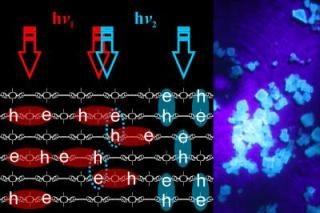Mar 10 2017
 The way of how the light with different wavelengths influences on a MOF crystal: different types of excitons are showed in red and blue (left). Image of crystals (right). Credit: ITMO University
The way of how the light with different wavelengths influences on a MOF crystal: different types of excitons are showed in red and blue (left). Image of crystals (right). Credit: ITMO University
Russian physicists and their European colleagues learned to generate excitons by changing the light parameters. The excitons are quasiparticles which are fully-controllable and helped to record information at room temperature.
These quasiparticles act as a transitional form between electrons and photons, and using these particles, the researchers believe that compact optoelectronic devices can be created for rapid recording and processing an optical signal.
The proposed technique involves the use of a special class of materials known as metal-organic frameworks (MOF). The study was published in Advanced Materials.
Scientists have brought in the concept of quasiparticles in order to simplify the description of intricate effects in quantum mechanics. One of them is called exciton, an "electron-hole" pair. The exciton transfers energy between electrons and photons.
The scientific community believes such mediation of quasiparticles can help to combine optics with electronics to create a new class of compact and energy-efficient equipment. However, all exciton demo devices can be operated only at low temperature, or do not facilitate easy manufacture which prevents their mass adoption.
In the new study, researchers from ITMO University in Saint Petersburg, Eindhoven University of Technology in the Netherlands, and Leipzig University in Germany, changed the light parameters to produce excitons at room temperature. The quasiparticles could also be controlled with ultra-high sensitivity of about hundreds of femtoseconds (10-13 seconds).
An easy method was also developed for recording of data by using excitons. All of this was enabled by employing a separate class of materials – MOF.
The ITMO University-synthesized MOFs have a layered structure. van der Waals force causes a physical attraction between the layers. An organic liquid is used to fill up the interlayer space to inhibit the plates from uncontrollably coming together, and to make the framework three-dimensional.
In these crystals, the researchers separately brought in two types of excitons: intralayer and interlayer. The first type develops when a photon is absorbed by the crystal and turns into an electron-hole pair within a layer. The second type appears when a hole and an electron belong to neighboring layers.
After some time, both types of quasiparticles break up, re-radiating the energy as a photon. However, excitons move around the crystal until they exist.
The intralayer excitons have a relatively short life time, but thanks to their high agility and density they can be used to produce light, for instance, in lasers and LEDs. The stability of interlayer excitons is more, but as the particles are slow-moving, the researchers plan to use them for recording of data. According to the physicists, both types of excitons can be used to process an optical signal.
The new technique for data recording involves the changing the distance between the crystal layers in order to switch "on" and "off" the interlayer excitons.
We locally heated the crystal with a laser. In the place of exposure, the layers stuck together and the luminescence of excitons disappeared while the rest of the crystal continued shining. This could mean that we recorded 1 bit of information, and the record, in the form of a dark spot, was kept for many days. To delete the data, it was enough to put the MOF into the same organic liquid that supports layers. In this case, the crystal itself is not affected, but the recorded information (the dark spot) disappears.
Valentin Milichko, Associate Professor, ITMO University
According to the authors, in the future the new material could be used to process an optical signal in the usual pattern of zeros and ones.
"In fact, we can influence the exciton behavior in the crystal, changing the light intensity. At weak irradiation, excitons are accumulated (in '1' state), but if the laser power increases, the concentration of quasiparticles grows so much that they can instantly disintegrate (in '0' state)," says Milichko.
Generally, excitons are found in semiconductor and dielectric crystals, but these scientists could create the quasiparticles and control them in a fundamentally different class of materials, hitherto not used for this. The MOF crystal is made up of organic and inorganic components, which provide additional properties not seen in materials of a single type.
The organic components allow excitons to be produced at room temperature, and their inorganic counterparts enable efficient transfer of the excitons around the crystal.